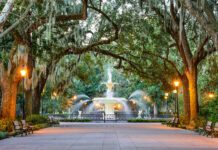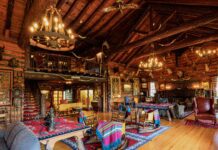We’ve all seen them, in books or museums or maybe in someone’s collection: snapshots from bygone times, capturing forever via an amateur’s lens something of great historical importance. It might be a political figure at a microphone, barely recognizable above the heads of the listening crowd. It could be a little black-and-white candid of a kid at play, taken by a friend or family member, well before the youthful subject grew up to be a familiar superstar. It might even be a shot snapped in a smoky club, the feeble light of the flashbulb illuminating a few members of a now-legendary band, onstage in a forgotten venue, playing for a crowd of youngsters who are now old or dead.
I don’t know about you, but I love those sorts of photos. Granted, they’re not professional, and sometimes their clarity and focus aren’t the best, but in a way that’s a part of their charm. They’re the only lasting record we have of something that needs to be remembered, and we should be grateful they exist at all.
Which brings us to Levon and the Hawks Recorded Live at the Fondalite Club, a brand new CD whose source material was a 56-year-old reel-to-reel tape. The disc is, in many ways, the aural equivalent of one of those old photos, an auditory snapshot that gives us a fascinating glimpse of a big event. In this case, it’s the final Tulsa appearance of a group that would soon become famous as Bob Dylan’s electric band and then, in 1968, as simply The Band. Under that name, the members would record Music from Big Pink, one of those albums that changed the face of rock music forever.
Three years before Big Pink’s ’68 debut, Connell R. Miller was a young rock ‘n’ roll guitarist based in Arkansas, playing the college circuit in and around his home state and also doing some work for a music figure named Dayton Stratton, who was not only a busy booking agent but also the co-owner of a Fayetteville club with rocker Ronnie Hawkins. Hawkins and Stratton were Arkansawyers as well; however, by the early ‘60s Hawkins had become such a draw in Canada that he had moved north of the border with his drummer Levon Helm and hired a new group of musicians from Ontario: pianist Richard Manuel, guitarist Robbie Robertson, bassist Rick Danko, and organist Garth Hudson.
Then, in late ’64, wanting to stretch their wings, those players broke away from Hawkins, going out on their own as Levon and the Hawks.
That’s where Tulsa comes in.
Dayton Stratton’s son Randy, who followed his father into the music business, explains:
“My dad brought ‘em back down here and booked ‘em on a little mini-tour,” he says. “First they were at the Rockwood Club [in Fayetteville], which my dad and Hawkins owned, on Christmas Eve. He booked them for about three dates over in eastern Arkansas, Levon’s home area, where they were well-known. Then he put ‘em down at Dallas Memorial Auditorium at the Cotton Bowl, where Arkansas was playing Nebraska for the national [college football] championship. Of course, all the students were there, and the Hawks were the band for the University of Arkansas, so that was an easy sell.
“They did shows at Dallas on New Year’s Eve and New Year’s day. After that, they were going to head back to Canada, and they started thinking, ‘Well, heck, it’d be great if we could pick up one more date on our way back.’”
They found it at a place they’d often played with Hawkins: Tulsa’s Fondalite Club. Dayton Stratton booked the gig, with an assist from Connell Miller, who got permission from Stratton to record the show on his 47-lb. Wollensack reel-to-reel recorder.
“The place was packed, and I really had a hard time setting the two mikes up,” he recalls. “Obviously, it’s in a club, with glasses tinkling and people talking. It’s not the best quality in the world, but it is what it is. I got 18 songs, and then I flat ran out of tape.”
That frigid January night in 1965 would be the last time Levon and the Hawks played in this part of the world. By the end of the year, they’d be touring as Bob Dylan’s band.
Meanwhile, Connell Miller held onto the tape he’d recorded that night at the Fondalite, not quite sure what to do with it.
“I’ve kept that thing under strict lock and key and made sure it went with me wherever I moved,” he says. “It was recorded to cassette many years ago by my brother, at a little too fast a speed, and since then it’s been replicated a few times, dubbed to other cassettes, so a few people have heard it. I always kind of wanted to do something about it, but I just never really did anything to put it out.”
Then, along came Randy Stratton.
“I’ve known about this thing for 20 years, and about a year ago, I got to thinking, ‘I wish there was a way to clean it up a little bit, to make it more presentable,’” Stratton says. “So I went to my friend Darren Novotny, a real good drummer, who has a studio and has done a lot of good work for the Cate Brothers [Band] and other people. He’s the one who digitally restored The Malibu Sessions, where the Cate Brothers played with Garth Hudson and Bonnie Raitt back in ’83. He restored that in 2014.
“So I took it to him, and he started tweaking it here and there, and the next thing you know, he’s cleaning it up and doing some pretty neat stuff. When you’ve got a two-track [tape] like that, you don’t want the crowd noise all the way up, but you want some of that authentic live sound with the audience. When you take the crowd noise out, you lose the music, too. But he found a way to bring the crowd noise down some, where you could hear the music better, and he just kept tweaking it, enhancing it. And when he digitally restored it, it came out decent enough for us to say, ‘Well, what the hell. It’s a piece of history. It’s not perfect. It’s a little rough. But it also gives you an inside look at the way things were back in those days.’ ”
“You know that old expression, ‘excitement in the air’?” asks Miller. “I think everybody was really pumped and ready that night. They were really on. I’ve heard other live recordings [of Levon and the Hawks], a few with maybe a song or two of better quality, but I think mine stands out because they played better than on any other of their live recordings I’ve heard. They’re playing cover songs, like they’d been doing for years, and Robbie is nothing like he was with The Band. You listen to him with The Band, and it’s just good fills that fit into the songs. But when you listen to him on this – he had a style all his own, and the tone he got out of his guitar and amps was really something.”
Miller also singles out Garth Hudson’s organ-playing on an original instrumental called “Home Cookin’.”
“I can’t imagine anyone’s fingers moving as fast as his did on that song,” he notes, “and I have not heard him play like that on anything else ever.”
Copies of Levon and the Hawks Recorded Live at the Fondalite Club are $19.70, postage and tax included, via PayPal at [email protected]. Cost outside the U.S. is $21.00.


























